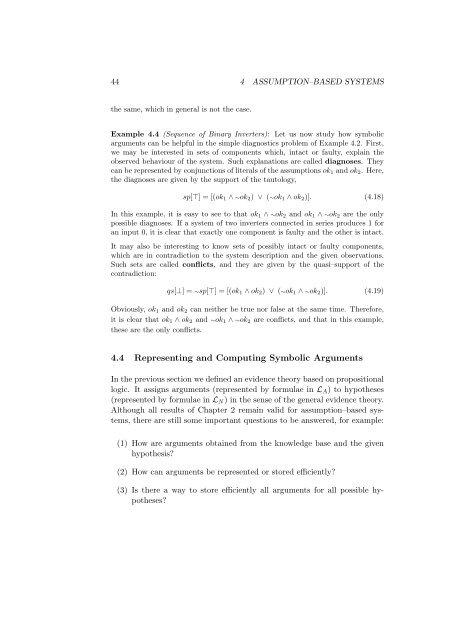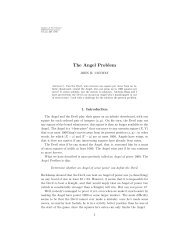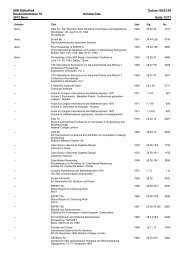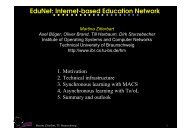Propositional Argumentation Systems and Symbolic Evidence Theory
Propositional Argumentation Systems and Symbolic Evidence Theory
Propositional Argumentation Systems and Symbolic Evidence Theory
Create successful ePaper yourself
Turn your PDF publications into a flip-book with our unique Google optimized e-Paper software.
44 4 ASSUMPTION–BASED SYSTEMS<br />
the same, which in general is not the case.<br />
Example 4.4 (Sequence of Binary Inverters): Let us now study how symbolic<br />
arguments can be helpful in the simple diagnostics problem of Example 4.2. First,<br />
we may be interested in sets of components which, intact or faulty, explain the<br />
observed behaviour of the system. Such explanations are called diagnoses. They<br />
can be represented by conjunctions of literals of the assumptions ok 1 <strong>and</strong> ok 2 . Here,<br />
the diagnoses are given by the support of the tautology,<br />
sp[⊤] = [(ok 1 ∧ ∼ok 2 ) ∨ (∼ok 1 ∧ ok 2 )]. (4.18)<br />
In this example, it is easy to see to that ok 1 ∧ ∼ok 2 <strong>and</strong> ok 1 ∧ ∼ok 2 are the only<br />
possible diagnoses. If a system of two inverters connected in series produces 1 for<br />
an input 0, it is clear that exactly one component is faulty <strong>and</strong> the other is intact.<br />
It may also be interesting to know sets of possibly intact or faulty components,<br />
which are in contradiction to the system description <strong>and</strong> the given observations.<br />
Such sets are called conflicts, <strong>and</strong> they are given by the quasi–support of the<br />
contradiction:<br />
qs[⊥] = ∼sp[⊤] = [(ok 1 ∧ ok 2 ) ∨ (∼ok 1 ∧ ∼ok 2 )]. (4.19)<br />
Obviously, ok 1 <strong>and</strong> ok 2 can neither be true nor false at the same time. Therefore,<br />
it is clear that ok 1 ∧ ok 2 <strong>and</strong> ∼ok 1 ∧ ∼ok 2 are conflicts, <strong>and</strong> that in this example,<br />
these are the only conflicts.<br />
4.4 Representing <strong>and</strong> Computing <strong>Symbolic</strong> Arguments<br />
In the previous section we defined an evidence theory based on propositional<br />
logic. It assigns arguments (represented by formulae in L A ) to hypotheses<br />
(represented by formulae in L N ) in the sense of the general evidence theory.<br />
Although all results of Chapter 2 remain valid for assumption–based systems,<br />
there are still some important questions to be answered, for example:<br />
(1) How are arguments obtained from the knowledge base <strong>and</strong> the given<br />
hypothesis?<br />
(2) How can arguments be represented or stored efficiently?<br />
(3) Is there a way to store efficiently all arguments for all possible hypotheses?








